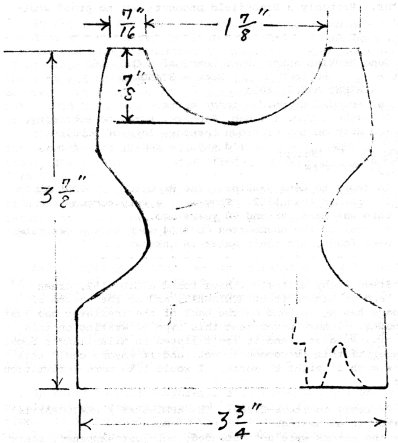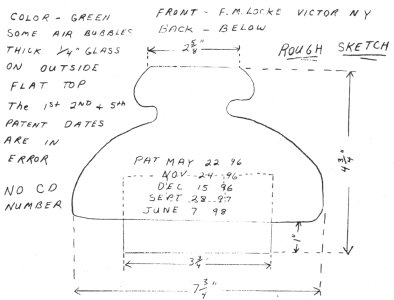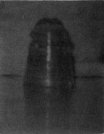Questions Answered by N. R. Woodward
Author of The Glass Insulator in America
Reprinted from "INSULATORS - Crown Jewels of the Wire", February 1974, page 6
From Jim Decker: I recently acquired two new Hemingrays and have questions
about each of them. The first one is a CD 162 with embossing as follows: F -
HEMINGRAY / PATENTED B - PETTICOAT
The second one is just like a CD 134-1P, except that it is about 1/2"
taller and has squatty sharp drip points. Embossing is as follows: F - HEMINGRAY
B - PATENT / MAY 2 1893
I would sure appreciate any information that you could give me on these two
jewels. Also, keep up the good work on your magazine. I really liked the drawing
on the front cover of the September issue. It brought many good memories of
scenes like that that used to be common around here.
- - - - - - - - -
In reply to Jim Decker: The Hemingray CD #162 and #134 that you describe are
regular production items from the period before World War I. The marking
PATENTED was used on some styles for a time, evidently after the drip point
patent expired. It is a little difficult to imagine which patent they had in
mind: but if there were no applicable patent covering the insulators themselves
at that time, there were probably a number of patents covering portions of the
manufacturing process at Hemingray, which would make the "Patented"
marking entirely valid.

Ed Patrick writes: Can't tell you how much I enjoy your publication or how
much it has helped me to build my collection. Thanks, and keep up the good work.
I have the above insulator and have had a hard time finding anything about
it. Can you help me? It is aqua and has no embossing. Thanks again.
- - - - - - - - -
In reply to Ed Patrick: This would be a CD #272, probably a Brookfield
product. It is catalogued as their No. 109. Your drawing does not correspond
exactly to the only Brookfield CD #272 that I have seen; but it is close enough
to be a different mold set for the same number.
From Larry Veneziano: Thought I'd write and describe an insulator I recently
picked up, wondering if you have ever heard of it: CD 127, front embossed W.U.P.,
on top in circle  VNM shape, aqua. Thanks for any research on it--how rare it is,
value.
VNM shape, aqua. Thanks for any research on it--how rare it is,
value.
- - - - - - - - -
In reply to Larry Veneziano: The W.U.P. would be Western Union Pattern, which
was the trade name of this insulator. Probably a Brookfield product--but no
proof whatever!
Gene Hawkins asks: Ever heard of a C.D. 162 Front - HG Co Back - STANDARD
PATENT MAY 2, 1893 aqua, w/ rounded drips, no inner skirt.
Or maybe a C.D. 104 Baby Beehive, aqua, no embossing, 1 inside drip on top of
crown threads, lots of bubbles. I'd enjoy a reply, but if not, okay!
I'd enjoy a reply, but if not, okay!
- - - - - - - - - -
In reply to Gene Hawkins: The H. G. CO. / STANDARD is CD #133, rather than
#162. They were a very common item when this was made, around 70 years ago.
Several of the unembossed CD #104 such as you describe have been found, but
their maker is unknown.
Steve Cichy writes: I have found a C.D. 152, green aqua, and it has on front
HEMINGRAY, and on the bottom of the name has No 40, and on the back of the
insulator has just HEMINGRAY. I have never seen this type of writing on this
type of insulator, and it isn't listed in Milholland's book. I wonder if this is
common or not, and if anyone could tell me how much it might be worth. I would
like more information on it.
- - - - - - - - -
In reply to Steve Cichy: The HEMINGRAY / No. 40 -- HEMINGRAY is an error in embossing.
Since the errors were not intended, but just happened, there is of course no
data on them and no way to know how long the mold was used.
From Pat Gavan: Thanks for exposing my query re the cast iron insulator
bracket to the power of "Reader Research" (page 23 August issue). Now
I have another puzzler.
I recently acquired a CD 106 Hemingray 9, JADE MILK, that was different from
any I had previously seen or heard of. The size is perfect, as is the color, and
it has many small sharp drip points. Back is embossed PATENT MAY 2 1893, but the
front is embossed HEMINGRAY /  Any information on this one?
Any information on this one?
Also have two (2) only "different" wood pins. The regular wood
insulator pin is 8" long w/4" tapered section and 2-1/8" of
threads; the "different" pins are full 9" long w/5" tapered
section and 3-1/8" of threads. They are very old.
Another new "find" of mine, that I cannot find listed, is a CD 162
light aqua embossed only BROOKFIELD on the skirt and OO on top of dome. Closest
I can find in Milholland's 1973 is line 939, but mine has no spelling error.
Base is smooth.
Hope someone can come up with some of the answers.
- - - - - - - - -
In reply to Pat Gavan: Regarding the Hemingray - 9 with the dots and the
extra "9" below the name: these dots appear on some Hemingray
insulators in connection with the removal of previous engraving from the molds.
The dots seem to be the tops and bottoms of letters that didn't get completely
covered. It looks as if the engraver may have put the PATENT MAY 2 1893 below
the name at first, for the extra 9 seems to be in about the right place for the
9 in "1893".
The wood pin with the extra long thread is a "standard
transposition" pin, for the two-piece or "Hibbard" transposition.
The one-piece CD #196 "Perfect Transposition" also fits this pin.
The CD #162 BROOKFIELD with OO on the crown is a relatively common item from
around 1915. But most of them are rather dark in color, so yours is a bit
unusual in that you say it is "light aqua".
Bill Humphrey writes: We are interested in all insulators - both glass and
ceramic. We have a glass insulator that doesn't appear in library books
(Tibbitts 1, 2 & 3), and we would appreciate it if you could identify it:
Base 4-1/2", Height 3-1/2", clear color, yellowish tinge above the
skirt(s), embossed (front) "CORNING PYREX REG. U.S. PAT. OFF",
embossing on back "MADE IN U.S.A. 131 14".

- - - - - - - - -
In reply to Bill Humphrey: Your Pyrex No. 131 was a regular stock item,
catalogued by Corning for a period of time. It is CD #240. However, it seems to
be a bit scarce, and I would suspect most collectors do not have it!
From Larry R. Martinson: I think I've come up with something that might be
one of a kind. It is a Fred M. Locke (sketch on page following) with five patent
dates, and it has a different design than any that I know of. Three of the
patent dates are wrong, which makes me think that probably not too many were
made. Perhaps it is an experimental? Any information will be appreciated. I'll
try to get a polaroid picture of it if you want. Let Mr. Woodward know of this
design if you want to, because he may want to assign a CD number to it if there
isn't any.

- - - - - - - - -
In reply to Larry R. Martinson: This is a CD #286, catalogued as Locke No. 17
in the year 1900. However, in less than two years they had re-designed No. 17 to
the saddle groove style of CD #300. Quite a few CD #286 have been located, so it
would seem that it gained a considerable amount of popularity during its short
life. Base diameter should be 6-3/4 inches. As to the patent dates, it seems the
mold engravers had a terrible time with them. Many errors are found. And,
furthermore, most of the dates concern patents that don't even apply to the
insulators on which they are molded!
From Fred A. Escher: Enclosed is a picture of an insulator I recently found,
for which I can find no information. The insulator is light green, has a double
skirt with a smooth base. It has a 4/10 inch long bar on the side. It measures
2-6/10 inches across the base and is 3-1/2 inches high. What CD# would this
insulator be, and is it a rare insulator? What would be it's value?

In reply to Fred A. Escher: Your insulator is a CD #146.5. I believe a very
few of them have been found, in the Midwest. Nothing is known concerning their
maker or origin.
EDITOR'S NOTE: if you have questions concerning a certain glass pin type
insulator, Mr. Woodward would be happy to try to answer them for you; but,
please, no value questions. It is too hard to set a value on someone else's
insulators. Mr. Woodward's policy is the same as that of Crown Jewels - to help
you with information all we can, but we just can't set a price on your
insulators. I'm sorry.
Dora
| 